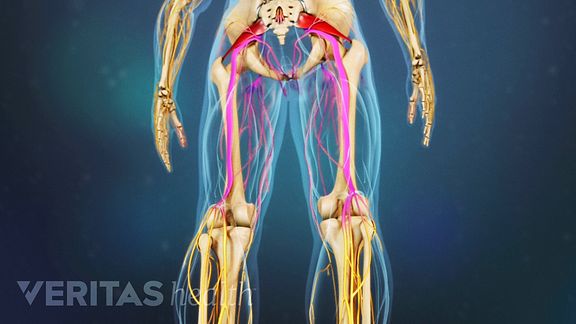尽管很普遍,梨状肌综合征广泛误解。为了帮助您加快速度,这里是你需要了解你的梨状肌的解剖结构和与之相关的痛苦是什么:
当梨状肌肌肉痉挛和刺激或压迫坐骨神经,引起坐骨神经痛的症状发生梨状肌综合征。看到梨状肌Syndrome Video
What is your piriformis muscle?
The first thing you need to know about your piriformis muscle is that it is located in your buttock. More specifically, the muscle starts in your lower spine and passes through your greater sciatic notch. It then attaches to the upper part of each of your femurs (you have a piriformis muscle on either side of your body).
Your piriformis muscle runs diagonally, and your large sciatic nerve runs below it. However, for some people all or part of their sciatic nerve runs through their piriformis muscle.
Your piriformis muscle has 2 main functions. First, it helps enable your hip to rotate. Second, your piriformis muscle allows your leg and foot to turn outward.
为什么它伤害了这么多?
梨状肌综合征是指一个条件,你的梨状肌肌肉痉挛和疼痛的原因在你的臀部。这也痉挛可加重附近的坐骨神经根,这反过来将坐骨神经痛的症状赛车下你的大坐骨神经。
看到坐骨神经痛症状
有几个你的梨状肌可能会痉挛,包括可能的原因:
- 您梨状肌的刺激或你的骶髂关节
- An injury that causes your piriformis muscle to tighten
- An injury that causes your piriformis muscle to swell
- Bleeding in the area around your piriformis muscle
看到Is My Pain Sciatica or Something Else?
Common symptoms of piriformis include:
- 沉闷的疼痛在你的臀部
- Increased pain when walking up an incline
- 坐了很长一段时间后疼痛加重
- 疼痛,刺痛,或在你的大腿,小腿,或足麻木
看到一个症状d Diagnosis of Piriformis Syndrome
Symptoms felt along your large sciatic nerve are not catergorized as sciatica. This is because your piriformis muscle is not located in your lumbar spine, but rather your buttock. This distinction is important because treatments may differ for piriformis syndrome compared to sciatica (which is caused by a variety of lower back conditions).
Part of the diagnosis process for piriformis syndrome is ruling out other possible disorders that can mimic piriformis syndrome symptoms, including骶髂关节功能障碍或腰椎间盘突出症。光这一点,如果你怀疑你有梨状肌综合症,你不要自我诊断是很重要的,而是安排与你的医生预约。







